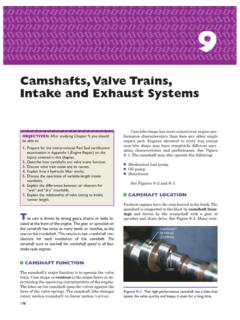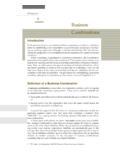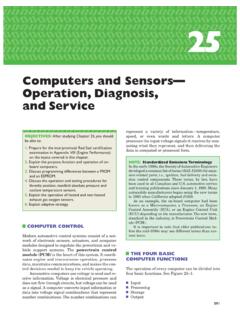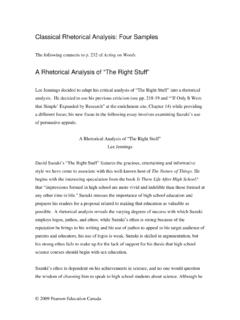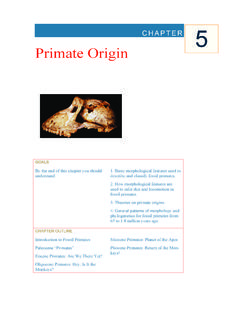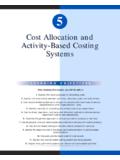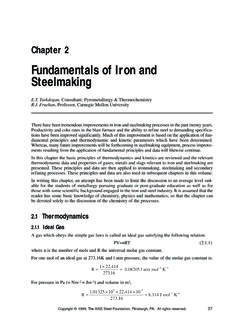Transcription of M07 PETR4521 10 SE C07 - Pearson
1 Natural gas consists mostly of methane, As we learned inChapter 4, the complete combustion of a hydrocarbon, such asmethane, yields carbon dioxide and water as products. More impor-tant, however, is another product of this reaction, which we have not pre-viously mentioned: heat. This heat can be used to produce hot water in awater heater, to heat a house, or to cook the branch of chemistry concerned with the heateffects that accompany chemical reactions. To understand the relationshipbetween heat and chemical and physical changes, we must start with somebasic definitions. We will then explore the concept of heat and the methodsused to measure the transfer of energy across boundaries. Another form ofenergy transfer is work, and, in combination with heat, we will define thefirst law of thermodynamics.
2 At this point, we will establish the relation-ship between heats of reaction and changes in internal energy andenthalpy. We will see that the tabulation of the change in internal energyand change in enthalpy can be used to calculate, directly or indirectly, energy changes during chemical and physical changes. Finally, conceptsintroduced in this chapter will answer a host of practical questions, such Started: SomeTerminology7-2 Heat7-3 Heats of Reactionand Calorimetry7-4 Work7-5 The First Law ofThermodynamics7-6 Heats of Reaction: and 7-7 Indirect Determinationof Hess s Law7-8 Standard Enthalpies ofFormation7-9 Fuels as Sources ofEnergy H: H UThermochemistry7 thermochemistry is asubfield of a larger disciplinecalled thermodynamics.
3 The broader aspects ofthermodynamics areconsidered in Chapters 19and 20. 241 Potassium reacts with water, liberating sufficient heat to ignite the hydrogen transfer of heat between substances in chemical reactions is an important aspectof 10/16/09 5:53 PM Page 241 REVISED242 Chapter 7 Thermochemistrywhy natural gas is a better fuel than coal and why the energy value of fats isgreater than that of carbohydrates and Started: Some TerminologyIn this section, we introduce and define some very basic terms. Most are dis-cussed in greater detail in later sections, and your understanding of theseterms should grow as you proceed through the the part of the universe chosen for study, and it can be as large as all the oceans on Earth or as small as the contents of a beaker.
4 Most of thesystems we will examine will be small and we will look, particularly, at thetransfer of energy (as heat and work) and matterbetween the system and its sur-roundings. The surroundingsare that part of the universe outside the systemwith which the system interacts. Figure 7-1 pictures three common systems:first, as we see them and, then, in an abstract form that chemists commonlyuse. An open systemfreely exchanges energy and matter with its surroundings(Fig. 7-1a). Aclosed systemcan exchange energy , but not matter, with its sur-roundings (Fig. 7-1b). An isolated systemdoes not interact with its surround-ings (approximated in Figure 7-1c).The remainder of this section says more, in a general way, about energy andits relationship to work.
5 Like many other scientific terms, energyis derivedfrom Greek. It means work within. Energyis the capacity to do work. Workis done when a force acts through a distance. Moving objects do work whenthey slow down or are stopped. Thus, when one billiard ball strikes anotherand sets it in motion, work is done. The energy of a moving object is calledkinetic energy (the word kineticmeans motion in Greek). We can seethe relationship between work and energy by comparing the units for thesetwo quantities. The kinetic energy of an object is based on its mass and1m2 FIGURE 7-1 Systems and their surroundings(a)Open system. The beaker of hot coffee transfersenergy to the surroundings it loses heat as it is also transferred in the form of water vapor.
6 (b)Closed system. The flask of hot coffee transfersenergy (heat) to the surroundings as it the flask is stoppered, no water vaporescapes and no matter is transferred. (c)Isolatedsystem. Hot coffee in an insulated containerapproximates an isolated system. No water vaporescapes, and, for a time at least, little heat istransferred to the surroundings. (Eventually, though,the coffee in the container cools to roomtemperature.) OpensystemEnergyEnergyEnergyEnergyClosed systemIsolatedsystemMatter (water vapor)(a)(b)(c)No energyin or outNo matterin or outSystemBoundary Isolated systemNo interactions occur acrossthe system boundary with 10/16/09 5:53 PM Page 242 REVISED7-1 Getting Started: Some Terminology243( )When the units for the expressions for work and energy are collected together,in both cases, the resultant unit is This corresponds to the SI unit ofenergy called the joule (J).
7 That is, The bouncing ball in Figure 7-2 suggests something about the nature ofenergy and work. First, to lift the ball to the starting position, we have to applya force through a distance (to overcome the force of gravity). The work we do is stored in the ball as energy . This stored energy has the potential to do workwhen released and is therefore called potential energy . Potential energyisenergy resulting from condition, position, or composition; it is an energy asso-ciated with forces of attraction or repulsion between we release the ball, it is pulled toward Earth s center by the force ofgravity it falls. Potential energy is converted to kinetic energy during thisfall. The kinetic energy reaches its maximum just as the ball strikes the its rebound, the kinetic energy of the ball decreases (the ball slows down),and its potential energy increases (the ball rises).
8 If the collision of the ballwith the surface were perfectly elastic, like collisions between molecules inthe kinetic-molecular theory, the sum of the potential and kinetic energies ofthe ball would remain constant. The ball would reach the same maximumheight on each rebound, and it would bounce forever. But we know this doesn thappen the bouncing ball soon comes to rest. All the energy originallyinvested in the ball as potential energy (by raising it to its initial position)eventually appears as additional kinetic energy of the atoms and moleculesthat make up the ball, the surface, and the surrounding air. This kinetic energyassociated with random molecular motion is called thermal general, thermal energy is proportional to the temperature of a system, assuggested by the kinetic theory of gases.
9 The more vigorous the motion of themolecules in the system, the hotter the sample and the greater is its thermalenergy. However, the thermal energy of a system also depends on the numberof particles present, so that a small sample at a high temperature (for example,a cup of coffee at ) may have less thermal energy than a larger sample ata lower temperature (for example, a swimming pool at ). Thus, temperature30 C75 C1 joule 1J2=1 kg m2 m2 *distance=3m1kg2*a1m s-224*d1m2kinetic energy =12*m1kg2*3u1m>s242velocity through the first equation below; work is related to forceand distance by the second 1m2*acceleration 1a241w21u2 FIGURE 7-2 Potential energy ( ) and kineticenergy ( )The energy of the bouncing tennis ballchanges continuously from potential tokinetic energy and back again.
10 The maximumpotential energy is at the top of eachbounce, and the maximum kinetic energyoccurs at the moment of impact. The sum and decreases with each bounce asthe thermal energies of the ball and thesurroundings increase. The ball soon comesto rest. The bar graph below the bouncingballs illustrates the relative contributions thatthe kinetic and potential energy make to thetotal energy for each ball position. The redbars correspond to the red ball, green barscorrespond to the green ball and the bluebars correspond to the blue ball. A unit of work, heat andenergy is the joule, but workand heat are not forms ofenergy but processesby whichthe energy of a system ischanged. 10/16/09 5:53 PM Page 243 REVISED244 Chapter 7 Thermochemistry7-1 CONCEPT ASSESSMENTC onsider the following situations: a stick of dynamite exploding deep within amountain cavern, the titration of an acid with base in a laboratory, and a cylinderof a steam engine with all of its valves closed.


